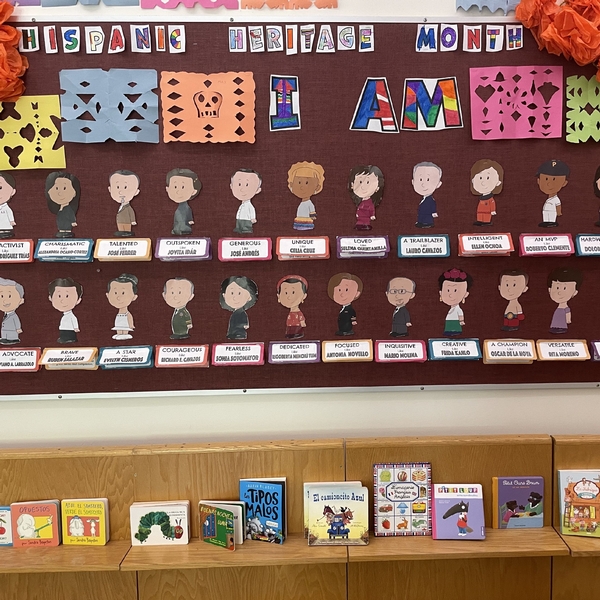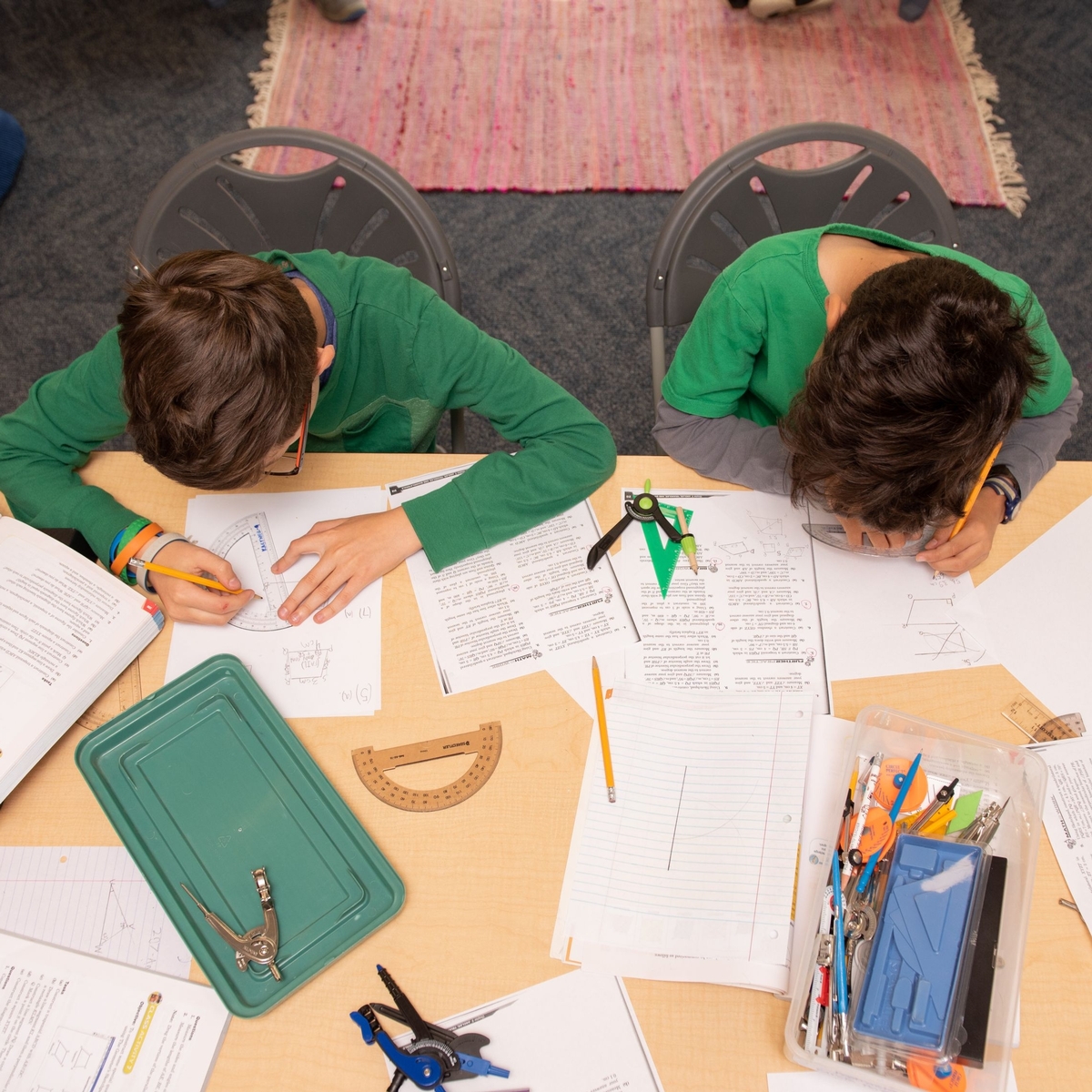Rigorous Academics & Thematic Learning
World Languages at SIS: An Interview with Madame Brie / Señora Brie (Briana Kuruzovich)

Madame / Señora Brie has been a part of the SIS family since 2019, when she began teaching in the after school French Club, officially joining the faculty in 2021 teaching both Spanish and French. In this blog, we learn about the inspiration and approach to world language learning at SIS!
Q: What inspired you to teach languages?
A: I've always loved geography, traveling, and exploring new cultures. I also love to learn new things and consider myself a lifelong learner. And I enjoy sharing all of that with others. Two things inspired me to learn and teach languages the most: My Cajun relatives, who spoke a language that I could not understand as a child but which fascinated me, and a month I spent traveling all around Europe when I was nine years old. I had never traveled by airplane up until that point, so going so far away and seeing so many new cultures and languages made a big impression on me and made me want to learn more about ways of life that are different from my own.
Q: Why is it important that SIS is committed to teaching students Spanish at an early age?
A: I love that SIS is committed to starting world language at an early age since childhood is the best time to learn a new language! Not only will children remember new phrases easily, but they organically come to the realization that people all over the world are different and that there's no one "right way" to speak or to be. Students learn that people think differently through the lens of their language. For example, in many languages, the word "ball" is different depending on the type of ball. Is it small and hard? Inflated? In English, we can get by with the word "ball" in both cases, but in some languages, a greater distinction is made. This shows that people categorize things in the world depending on what language they speak. The idea that we don't all see things the same way, and that's OK, is fundamental to language learning.
Q: What techniques do you find most effective?
A: In an effort to make learning a foreign language as natural for our students as possible, Señora Chocolate and I provide comprehensible input. That means the language they hear in class is at a level slightly above their ability but can be understood through visuals, context, cognates, etc. Therefore, foreign language learning mimics the way students learned their native language, by hearing speech repeatedly and gaining understanding naturally. One way I do this with the younger students is by mirroring what they are doing in their other classes but in Spanish. So every class starts with introductory songs paired with movement, and we talk about the calendar and the weather. Tons of vocabulary is embedded in this: greetings and responses in our songs, numbers as we count to the date, the colors of the numbers on the calendar, the days of the week, and obviously weather expressions and seasonal vocabulary. The kids start picking up on these things quickly, and before long they can say "It's sunny" without ever having been taught it explicitly because they have been hearing and using these words in an organic way.
Q: How is the addition of French impacting our students?
A: I think it's important for students to be able to choose the language they pursue. The more interested a student is, the better they are likely to do. People might have a strong interest in one or the other - maybe they like the sound of a certain language, maybe it's family heritage - whatever the case may be, it's good to have options. Sometimes parents worry that children will get confused learning multiple languages, but that is the best time to do it! Our brains were designed to pick up language. Students who take both Spanish and French will notice many similarities due to their Latin origin and generally seem to have an easier time with the second foreign language since they already have somewhat of a base in the first. Studies have proven that being multilingual strengthens cognitive abilities, as well as makes people more tolerant towards other cultures. I tell my students that knowing more than one language is a superpower!
Rigorous Academics and Thematic Learning

Students learn in a variety of ways. There is no right or wrong way, and as a parent, you know the environment in which your child will flourish and grow. Rigorous academics and thematic learning offer a unique and proven platform. Children learn through stimulating and engaging studies based on a highlighted theme across multiple disciplines.
What is meant by “rigorous academic work?”
Rigorous academic learning is not about instruction given in a harsh or disciplinary environment. On the contrary, educators believe that students flourish in a challenging yet not difficult climate. The Glossary of Education Reform defines it as,
“Rigorous learning experiences, for example, help students understand knowledge and concepts that are complex, ambiguous, or contentious, and they help students acquire skills that can be applied in a variety of educational, career, and civic contexts throughout their lives.”
It is further defined, “In education, rigor is commonly applied to lessons that encourage students to question their assumptions and think deeply, rather than to lessons that merely demand memorization and information recall. Thus, for example, a fill-in-the-blank worksheet or multiple-choice test would not be considered rigorous by many educators.”
What is thematic learning?
Thematic learning enhances the foundation of rigorous academics by building the curriculum on a specific theme for teaching one or more concepts and subjects.
Thematic learning is based on the idea that knowledge acquisition is efficient among students when they learn in a coherent and holistic way and when they can associate whatever they learn to their surroundings and real-life examples. Thematic instruction seeks to put cognitive skills such as reading, thinking, memorizing, and writing in the context of a real life situation under the broad aim of allowing creative exploration. (k12academics.com)
Students beginning thematic learning in elementary school, including kindergarten, begin to build a depth of knowledge built upon the ability to connect things that may not seem connected at first. This applies to understanding the impact, for example, that science and technology have on history. Thematic learning encourages open-ended learning based on your beliefs and experiences.
What are excellent examples of rigorous academics and thematic learning?
Rigorous Academics
Academic Rigor at Saratoga Independent School happens by creating classrooms and learning communities that enhance content and allow for deep thought. Teachers carefully plan using State Standards, quality research-based curricula, and knowledge of their individual students’ strengths.
At Saratoga Independent School, there is a high expectation that students will do their best by rising to the challenge of the higher level of thinking which their teachers know they are capable of achieving. Students are encouraged to demonstrate knowledge through various pathways, including hands-on learning, rich discussions, portfolios, and written assessments.
An example of rigor at Saratoga Independent School in a Primary Social Studies class shows students brainstorming the meaning of a timeline. They then will make a “human” timeline to line up in the order of their birthdays. After this, they write the timelines of a school day. Then, they each design their timeline from their birth to the present day. Within these activities, the teacher scaffolds lessons on concepts such as a timeline, a graphic depiction of the passage of time, discussing chronological order, past and present, and math and literacy skills. This project teaches content while allowing each student’s individuality to be expressed through their creativity, culture, and deep discussion of their own chain of events that made them who they are today.
Theme-Based Learning
The essential notion of theme-based teaching is that many different activities are linked together by their content; the theme or topic runs through everything in the classroom and acts as a connecting thread for students and teachers.
Saratoga Independent School’s curriculum follows theme-based learning. The themes are interwoven through all subject areas and across grade levels. Pre-K through K-5 and middle school all use this approach to learning. This research-based curriculum supports the mission statement of the school in various forms. In addition, theme-based teaching lends itself to critical thinking, problem-solving, and teamwork.
Thematic units such as Bridges To People, and Places and Times present opportunities for learning across content areas. While studying Ancient Civilizations Thematic Social Studies, students can apply content learned in science through a Simple Machines unit. This provides an opportunity for students to connect the two by building what they have learned. Through hands-on exploration, students can analyze how simple machines affected the development of civilizations. Then, three years later, the students will learn how those ancient civilizations influenced the structure of today’s government.
How do I know if this is the right learning environment for my child?
Ultimately, you are the only person who can answer this question. However, here are some guiding questions that can help determine if a school is a good fit for your child and your family.
First, think about what is important to you? Is it safety? The school’s approach to learning? Small class sizes and an individualized approach to learning? Write down your top five priorities and ask these questions when on your visit/tour.
Second, ask to see the school’s mission. The mission creates the culture for the school. At Saratoga Independent School, our mission is at the crux of everything we do. For example, part of our mission statement says that we “empower students to be curious and confident learners”. Prospective families can view our website, walk through our hallways, and see examples of how we encourage opportunities for leadership and the sharing of ideas through rich discussions.
Lastly, you’ll know the people who are connected to the school. The pride and passion that faculty and staff have for their students will always shine through when sharing information about their school. Walking through the halls at Saratoga Independent School, you’ll notice people will stop to greet you on your tour. We love to talk about who we are and what we offer. Currently, enrolled families are also great resources. When you visit, you’ll get a feeling that creates a sense of belonging in a community you’ll want to be a part of too. Ultimately, it’s the people and that feeling that will help to reassure you that you have found the right place.
Schedule a Campus Tour
We love to show off what we’ve got and how we work! Our private and virtual tours are designed to give a peek inside our school and learn about our strong academics and caring culture. We will meet with you safely outside (or virtually), show you the campus, and answer any questions that you may have. Schedule a tour or contact Colleen Fortune, Admissions Liaison, at cfortune@siskids.org for more information or to schedule a visit.
resources: https://www.edglossary.org/rigor/ and k12academics.com
